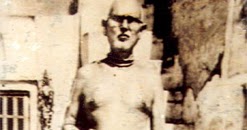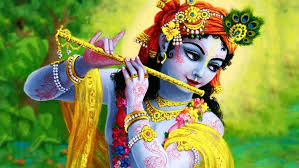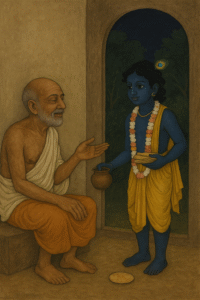The Life of Śrī Kuñja Bihāri Dās Bābājī (1896-1976)
Early Life and Background
Kuñja Bihāri Dās Bābājī was born as Kuñja Kishor Tewari in the village of Meshya, near Jhalda, in the Purulia district of northwestern Bengal. He made his appearance on the auspicious day of Jhulan Purnima in 1896 as the only son of Nilakamal Tewari and Muktamala Devi. From an early age, Kuñja Kishor showed an interest in spiritual subjects, learning the Bengali versions of the Mahābhārata and Rāmāyaṇa from his uncle, Nilamadhab Tewari. During this time, the Caitanyaite religion was not well known in his region, and Kuñja Kishor’s first attraction was towards the Rāma-carita Mānas of Tulsidas. It was not until the mid-1920s that he encountered the Bhāgavata Purāṇa, which he read with the translation and commentary by Rādhāvinoda Goswami.
Education and Early Influences
Despite limited formal education, Kuñja Kishor opened a primary school in his village, where he taught for twenty years. His primary interests continued to be religious, yet he also engaged his students in the nationalist Svadeshi movement by growing cotton and spinning it to make homespun cloth. He was particularly influenced by Nibaran Chandra Dasgupta, the publisher of Mukti magazine, which was the main organ of the Congress party in the district. Nibaran Chandra was also a Vaiṣṇava who saw independence as a means of improving the status of the Caitanyaite religion. Kuñja Kishor was influenced by his teachings, particularly his attitude towards the proliferation of self-proclaimed religious leaders in Bengal.
Spiritual Awakening and Visions
In 1922, Kuñja Kishor’s father, Nilakamal Tewari, passed away. Kuñja Kishor followed the obligatory mourning rituals, including the śrāddha ceremony. Shortly thereafter, he fell ill and experienced repeated strong fevers for about eight months. During the rainy season of 1923, he underwent a period of what he himself described as unmāda, or “insanity.” He experienced this time as one of great joy and liberty, claiming to have had visions of Rādhā and Kṛṣṇa and hearing divine sounds. Later in life, he looked back on this period as a precursor to his spiritual experiences at Rādhā Kuṇḍa.
The Seva Ashram and Vaiṣṇava Festival
Despite his spiritual distractions, Kuñja Kishor’s school continued to be successful, with many of its graduates going on to win scholarships for further study. Though he used the school as a platform for religious and political activity, there was little objection from the school inspectors. One of his unusual classroom practices was keeping a human skull on display to remind his students of the impermanence of life. Gradually, the school grew, and a new building with the aspect of an ashram was erected in the middle of a field and given the name Sevāśrama. A three-day Vaiṣṇava festival, which continues to be held there annually, was inaugurated by Kuñja Kishor’s uncle, Subal Chandra Tewari.
Influence of Sahajiya and Baul Teachings
In the early 1930s, the influence of Sahajiya and Baul teachings began to be felt in the district, and some close friends of the Tewari family became members of these sects. Kuñja Kishor felt fortunate to meet a traveling Vrindavan Vaiṣṇava, from whom he learned about many aspects of Vaiṣṇava teachings preserved in Vrindavan, including the disciplic succession and the importance of siddha-praṇālī in Gauḍīya Vaiṣṇava tradition. Although he had been initiated by Gopal Chandra Thakur Goswami of Jhalda at the age of ten or eleven, he now took steps to recover the knowledge of siddha-praṇālī, which he saw as the key to further spiritual advancement.
Confrontation with Heterodox Movements
With renewed enthusiasm and a deeper understanding of orthodox Vaiṣṇavism, Kuñja Kishor managed to convert several of his Sahajiya and Baul neighbors to the path of pure Vaiṣṇavism. This caused a stir, and the Bauls began a campaign of criticism against Vaiṣṇava orthodoxy. In response, a great assembly was held at the Sevāśram in November 1934 to establish the supremacy of the orthodox movement. Many guest speakers from the Vaiṣṇava community, led by scholar Vrajendranath Chakravarti of Jhalda, attended the meeting. As a result, the influence of the Tantric subsects of Gauḍīya Vaiṣṇavism in the district was significantly diminished.
Personal Loss and Continued Devotion
Unfortunately, only a few weeks after this success, Kuñja Kishor’s wife died during childbirth. He continued his life as a teacher for several more years while fulfilling his responsibilities towards his two daughters, Vinodinī Devī and Janakī Bālā, ensuring their education and marriage. During this time, he continued to organize large assemblies in the name of the Gauḍīya-Vaiṣṇava-Dharma-Saṁrakṣinī Sabhā (Council for the Protection of the Gauḍīya-Vaiṣṇava Religion). Those who had been initiated were encouraged to learn their siddha-praṇālī, while those initiated in heterodox movements were encouraged to seek reinitiation. He also collected funds to organize mṛdaṅga and kīrtana classes at Sevāśram and formed a kīrtana group with participating students.
Meeting Kṛṣṇa Caitanya Dās Bābājī
Kuñja Kishor’s dedication to Vrindavan orthodoxy reached the ears of Kṛṣṇa Caitanya Dās Bābājī of Rādhā Kuṇḍa, originally from Jhalda. Kṛṣṇa Caitanya Dāsjī wrote to him, expressing a feeling of deep friendship across lifetimes. This connection with a great monk like Kṛṣṇa Caitanya Dāsjī further diminished Kuñja Kishor’s interest in material life. In 1937, during the Kumbha period, he went to Rādhā Kuṇḍa for a month’s holiday and accepted Kṛṣṇa Caitanya Dāsjī as his śikṣā-guru, receiving Pañca-tattva and other mantras, as well as worship instructions.
Renunciation and Life at Rādhā Kuṇḍa
In 1939, Kuñja Kishor returned to Braj with his mother, this time permanently. He was immediately initiated into the renounced order by Advaita Dās Bābājī of Govardhan, receiving the name Kuñja Bihāri Dās Bābājī. A few months later, his mother also took the renounced order from Advaita Dāsjī, receiving the name Mādhavī Dāsī. She continued to live near the Gopa Kuwā at Shyam Kuṇḍa until her death in 1944.
Contributions to Vaiṣṇava Literature and Teachings
Kuñja Bihāri Dāsjī found a cottage at Brajānanda Gherā, where, with donations from his countrymen, he greatly improved the building. He established a publishing house named the Kṛṣṇa Caitanya Śāstra Mandir after his śikṣā-guru. He published numerous books, including Bhavakūpe Jīver Gati, Paratattva Sammukhya, Bhakti-kalpa-latā, Bhakti-rasa-prasaṅga, and Mañjarī-svarūpa-nirūpaṇa. He also produced many paintings and charts to help explain Vaiṣṇava teachings. His book Bhakti-rasa-prasaṅga was even used as a required text for an M.A. course at the University of Patna.
Teachings on the Mood of the Mañjarī
In his introduction to Mañjarī-svarūpa-nirūpaṇa, Kuñja Bihāri Dāsjī writes that his first acquaintance with the mood of the mañjarī was through his renunciation guru, Śrī Advaita Dās Bābājī of Govardhan. From that time on, he became especially interested in the subject, collecting references to the mood of the mañjarī and paying special attention to the ingredients necessary to produce the experience of sacred rapture. Later, he had the opportunity to live for a long time with another great scholar and resident of Rādhā Kuṇḍa, Dīnaśaraṇa Dās Bābājī, and thoroughly studied all the literature on the subject.
Influence and Legacy
Kuñja Bihāri Dāsjī made many disciples, several of whom later became abbots of Rādhā Kuṇḍa. His most celebrated disciple, Ananta Dās Bābājī, became a great scholar in his own right and published numerous works from the Kṛṣṇa Caitanya Śāstra Mandir. Kuñja Bihāri Dāsjī’s influence continues to be felt in his homeland, which its inhabitants identify with Jharikhand, the wild jungle country through which Caitanya Mahāprabhu passed on his way from Puri to Vṛndāvana in 1513, avoiding the more frequented route along the Ganges. The proportion of bābājīs living in Rādhā Kuṇḍa who come from the westernmost part of Bengal is well over 50%. Vaiṣṇavism in the Purulia district continues to bear the strong stamp of the practices found in Rādhā Kuṇḍa.
Kuñja Bihāri Dās Bābājī disappeared from this world in 1976 at the age of 80.
Lessons from the Life of Kuñja Bihāri Dās Bābājī
- Devotion and Resilience: Despite the challenges in his personal life, including the loss of his wife, Kuñja Bihāri Dās Bābājī remained steadfast in his devotion to Vaiṣṇavism. His resilience in the face of hardship is an inspiration to those on the spiritual path.
- Commitment to Tradition: Kuñja Bihāri Dās Bābājī was deeply committed to the orthodox practices of Gauḍīya Vaiṣṇavism. He worked tirelessly to revive and protect the traditional teachings and practices, even when faced with opposition from heterodox movements.
- Humility and Renunciation: He demonstrated humility and a willingness to renounce material comforts for the sake of spiritual advancement. His journey from a teacher to a renounced Vaiṣṇava monk exemplifies the transformative power of humility and surrender to a higher purpose.
- Dedication to Teaching: Kuñja Bihāri Dās Bābājī’s dedication to teaching—whether through his school, kīrtana groups, or the books he authored—highlights the importance of sharing knowledge for the upliftment of society. He used his skills and resources to educate others and spread the teachings of Vaiṣṇavism.
- The Power of Association: His life demonstrates the power of associating with great spiritual personalities. His relationship with his śikṣā-guru, Kṛṣṇa Caitanya Dās Bābājī, and his renunciation guru, Advaita Dās Bābājī, played a crucial role in his spiritual journey and helped him deepen his understanding of the path of devotion.
Prayer
O Supreme Lord, may I learn from the life of Śrī Kuñja Bihāri Dās Bābājī to remain humble, resilient, and devoted to You. May I strive to uphold the true teachings of the tradition, serve others selflessly, and seek the association of pure devotees. Please bless me with unwavering faith and dedication on my spiritual journey, just as Kuñja Bihāri Dās Bābājī exemplified in his life.



